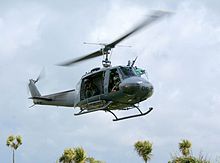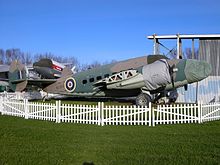- No. 3 Squadron RNZAF
-
No. 3 Squadron Royal New Zealand Air Force
3 Squadron badge on Iroquois in late 1980sActive Since 1930 Country New Zealand Allegiance  New Zealand
New ZealandBranch  Royal New Zealand Air Force
Royal New Zealand Air ForceRole Battlefield helicopter Size One Squadron Motto Kimihia Ka Patu (Seek and Destroy) Colors Red and Black Battle honours 3 Squadron is a unit of the RNZAF. It remains on active duty.
Contents
History
No. 3 Squadron RNZAF formed as a Territorial unit of the New Zealand Permanent Air Force based at Christchurch in 1930.
Pilots attached to the squadron used NZPAF aircraft based at Wigram until No.3 Squadron got its first aircraft Blackburn Baffin torpedo bombers, in 1938.
Following the outbreak of war the unit was equipped with Vickers Vincent and Vickers Vildebeest torpedo/patrol bombers and was tasked with protecting shipping entering Lyttelton harbour.
The squadron received modern aircraft in the form of Lockheed Hudsons converting to the patrol bomber role and in November 1942 became the first RNZAF squadron deployed forward in full strength to engage the Japanese, operating from Henderson Field at Guadalcanal in the South Pacific in a reconnaissance role. They replaced dive bombers and long range heavy bombers in this role. Despite being lightly armed, a Hudson of F/O Gudsell twice saw off attacks by three Japanese aircraft; Gudsell was awarded the Air Medal (US).
The Squadron subsequently re-equpped with Lockheed Venturas and saw service from Espiritu Santo, Bougainville, Emirau, Green Island and New Britain.
From 1948 to 1957 No.3 Squadron reverted to being a territorial squadron, based at Wigram with de Havilland Tiger Moths, North American Harvards and P-51 Mustangs. It subsequently operated transport types such the Bristol Freighter and Army co-operation types such as the Auster AOP, before becoming a dedicated helicopter squadron in 1965, based at Hobsonville, Auckland, and equipped with Bell 47s, and from the end of the year Bell UH-1 Iroquois, a type it still operates.
The Squadron's Naval Support Flight flew helicopters for the Royal New Zealand Navy's frigates from 1966 until October 2005, when the role was transferred to 6 Squadron. The flight flew Westland Wasps, and later Kaman Seasprites of the naval air wing attached to the squadron from 1966 to 2005.
Pilots from No. 3 Squadron served in Vietnam and in UN peace keeping in the Sinai. The Squadron served in East Timor. For many years a detachment was based in Singapore, to support the New Zealand Army presence there, and combat Indonesian insurgents. Detachments have recently served in the Solomon Islands and Antarctica.
No. 3 Squadron UH-1s transported the paticipants on the first episode of Survivor: Heroes vs. Villains.
Today, No. 3 Squadron provides tactical air transport for the army. The Iroquois are scheduled to be replaced by NH90s.
Current Strength
The squadron has a total personnel strength of approximately 135, and operates the following aircraft:
- Utility Flight of 13 UH-1H Iroquois based at RNZAF Base Ohakea. UH-1H helicopters will remain in service until NH-90 is fully operational.
- Training Flight of 5 Bell-47 Sioux based at RNZAF Base Ohakea. These helicopters have been retired.
- Training and Light Support Helicopter- 8 Agusta A109LUH helicopters. 3 in service with the remainder to arrive by 2012
- Medium Transport Helicopter- 9 NH-90 helicopters, due 2011
The Ministry of Defense has an ongoing (as of 2008) helicopter replacement program that is to replace the Iroquois with 9 new NH90 Medium Utility Helicopters for NZ$771 million,[1] and the Bell-47 Sioux with 5 A109. The A109 will also provide the Airforce with a light utility and counter-terrorist support role.[citation needed]
Accidents
On 25 April 2010, at about 5.45am, a UH-1 Iroquois crashed near Paekakariki Hill Rd, about 40 km north east of Wellington. The Iroquois was enroute to Anzac Day commemorations from RNZAF Base Ohakea when the helicopter crashed into a steep hill in the morning darkness, killing 3 men. A 4th crew member survived the crash with serious injuries. The cause of the crash is not yet known.
Preserved Aircraft
An Auster AOP operated by the squadron is at the Royal New Zealand Air Force Museum, together with an Iroqouis in 3 Squadron colours, and a Westland Wasp and an early F model Kaman SH-2 Seasprite formerly operated by the squadron's naval flight. Another Wasp is preserved in the Museum of Transport and Technology, together with a Lockheed Hudson used by both No. 2 and 3 Squadrons. A number of ex 3 squadron Bristol Freighters have survived, including one in the Royal New Zealand Air Force Museum.
References
- ^ Mateparae, Jerry (8 September 2008). "Jerry Mateparae: Can't fight? In fact we still punch above our weight". The New Zealand Herald. http://www.nzherald.co.nz/nz/news/article.cfm?c_id=1&objectid=10531009. Retrieved 31 October 2011.
External links
Categories:- Royal New Zealand Air Force squadrons
- Military units and formations of the RNZAF in World War II
- Royal New Zealand Air Force
- Military units and formations established in 1930
- 1930 establishments in New Zealand
Wikimedia Foundation. 2010.




